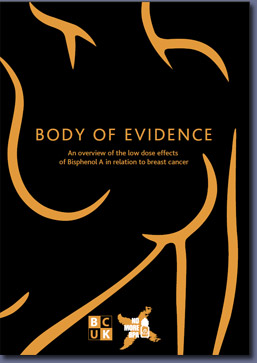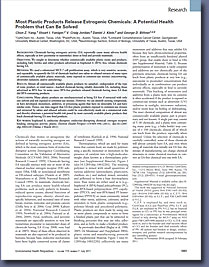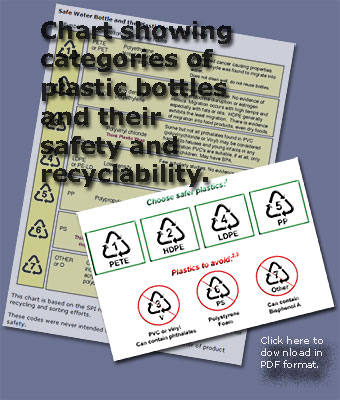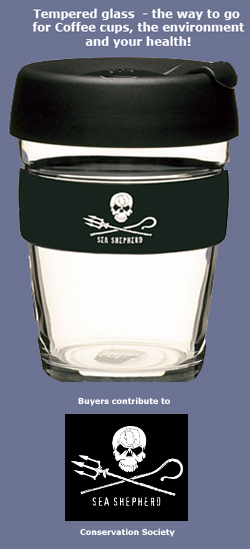 |
 |
|
Those fizzy drinks, baby food containers, and water bottles may be providing more than just their contents! updated Augsut 2018 A special report by Unionsafety Web editor, Chris Ingram: It has been known for years that chemicals in the plastics that your bottles and food containers are manufactured from, can leach out into the food and drink contents; and hence into your body. The possibility of a person developing a form of cancer due to the ingestion of such chemicals is well documented - it is only the degree of risk that is under debate!
There is now compelling evidence that low dose exposure to the hormone (endocrine) disrupting chemical (EDC), Bisphenol A (BPA), could be contributing to the rise in the disease. The human population is exposed on a daily basis to hundreds of pollutant chemicals; many of which are now known to enter human breast tissue and which can mimic or interfere in the actions of the female hormone, oestrogen. Bisphenol A (BPA) present on most plastic food and drink containers; is one such chemical. Humans are exposed to BPA through a variety of different sources including till receipts, mobile phones and laptops. However, it is thought that diet is the main route of exposure. Further, in mammals, chemicals having EA (estrogenic activity) can produce many health-related problems, such as early puberty in females, reduced sperm counts, altered functions of reproductive organs, obesity, altered sex-specific behaviours, and increased rates of some breast, ovarian, testicular, and prostate cancers. Many of these effects observed in mammals are also expected to be produced in humans, because basic endocrine mechanisms have been highly conserved across all classes of vertebrates. If you have been living in Europe or the US it is highly probable that you have BPA in your system, as 90% of Europeans and Americans have detectable amounts. Plus 3,175 million tons of BPA are produced annually, and BPA ends up in a number of consumer goods including polycarbonate plastic products (reusable water bottles, sippy cups, leftover containers, baby bottles, and toys), the lining of canned foods, baby formula and beverages, pizza boxes, and other fast food containers. However, much less is known about the chemicals used to replace BPA in plastic products; which begs the question: The researchers sampled almost all commercially available plastic products, and found that independent of the type of resin, product, or retail source; leached chemicals contained reliably detectable EA, including those advertised as BPA free. The researchers concluded from the study that many plastic products are mischaracterised as being EA free. However, they also stated: “we can identify existing compounds, or have developed monomers, additives, or processing agents that have no detectable EA and have similar costs. Hence, our data suggest that EA-free plastic products exposed to common-use stresses and extracted by saline and ethanol solvents could be cost-effectively made on a commercial scale and thereby eliminate a potential health risk posed by most currently available plastic products that leach chemicals having EA into food products.” A study in Germany in 2009 found that bottled water was contaminated with eostrogen which had leached out of the plastic bottles used. Martin Wagner and Jörg Oehlmann, from the Department of Aquatic Ecotoxicology at the Goethe University in Frankfurt, Germany, declared that their study showed that plastic mineral water bottles contaminate drinking water with xenoestrogens. In their report on commercially available mineral waters, published in the journal Environmental Science and Pollution Research, the researchers explain how they analyzed 20 brands of mineral water available in Germany - nine bottled in glass, nine bottled in plastic and two bottled in composite packaging (paperboard boxes coated with an inner plastic film). They took water samples from the bottles and tested them for the presence of estrogenic chemicals in vitro and also carried out a reproduction test with the New Zealand mud snail to determine the source and potency of the xenoestrogens. They detected estrogen contamination in 60 percent of the samples (12 of the 20 brands) analyzed. Mineral waters in glass bottles were less estrogenic than waters in plastic bottles. Specifically, 33 percent of all mineral waters bottled in glass compared with 78 percent of waters in plastic bottles and both waters bottled in composite packaging showed significant hormonal activity. Prior to the American study being published, on 24 April 2012 the European Food Safety Authority (EFSA) announced that it had started work on a new risk assessment of BPA used in food contact materials (such as packaging and containers, kitchen equipment, cutlery and dishes), focusing specifically on its exposure to vulnerable groups. * Label #7, are usually made with polycarbonate (PC) plastics. So avoid them too. * Use plastic containers made from from of non-leaching chemicals. For example, 'Tritan' is made by Eastman and is a BPA-free plastic — it is not manufactured with bisphenol A (BPA) or other bisphenol compounds, such as bisphenol S (BPS). It has been extensively tested and found to be safe to humans. * Do not microwave plastics, either BPA or BPA-free, and don't leave your plastics sitting in the sunlight, especially when they contain food and drink. You can download the research study findings and the findings of the study sponsored by Breast Cancer UK from the Unionsafety E-Library Database using keyword ‘Bisphenol’. Source: Breast Cancer UK / Field Fisher Waterhouse / Alliance for Cancer Prevention / EDC Free / The Independent / Environ Health Perspectives / US National Library of Medicine National Institutes of Health / European Food Standards Agency / Environmental Science and Pollution Research / Eastman |



 According to the ANSES report, till receipts may pose health risks to pregnant women and their foetuses, especially cashiers who are constantly in contact with them. But more research is needed for a thorough analysis. Last year, similar concerns were raised in Sweden.
According to the ANSES report, till receipts may pose health risks to pregnant women and their foetuses, especially cashiers who are constantly in contact with them. But more research is needed for a thorough analysis. Last year, similar concerns were raised in Sweden.